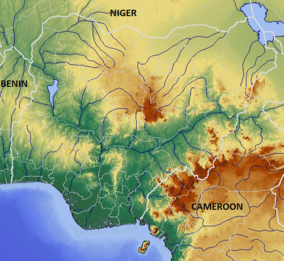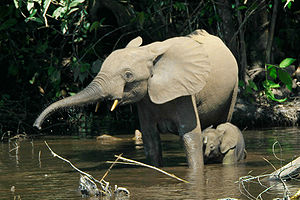- Okomu National Park
-
Okomu National Park IUCN Category II (National Park)Location Ovia South-West, Edo State,  Nigeria
NigeriaNearest city Udo Coordinates 6°20′0″N 5°16′0″E / 6.333333°N 5.266667°ECoordinates: 6°20′0″N 5°16′0″E / 6.333333°N 5.266667°E Area 200 km² Established 1935 The Okomu National Park, formerly the Okomu Wildlife Sanctuary, is a forest block within the 1,082 km² Okomu Forest Reserve in the Ovia South-West Local Government Area of Edo State in Nigeria. The park is about 60 km north west of Benin City.[1] The park holds a small fragment of the rich forest that once covered the region, and is the last habitat for many endangered species. It continues to shrink as villages encroach on it, and is now less than one third of its original size.[2] Powerful corporations are involved in plantation development and logging concessions around the park, which also pose a threat.[3]
Contents
History
The park holds a remnant of the Nigerian lowland forests that once formed a continuous 50–100 km wide belt from the Niger River west to the Dahomey Gap in Benin. To the south and southeast the forest was separated from the coast by mangrove and swamp forests, while to the north it merged into the Guinean Forest-Savanna Mosaic ecoregion. Human pressure is not new. In the Okomu park there is an extensive layer of charcoal and pottery below the forest, indicating that it was cleared and then regenerated over the last 700 years. By the start of the 20th century the forest survived only in disconnected blocks, which were under intense pressure from human activity. The British colonial administration set up a series of forest reserves to manage what remained, including controlled extraction of valuable trees such as African Mahogany.[4]
Khaya senegalensis, or African Mahogany. This specimen is growing further inland, near Mount Tenakourou, Burkina Faso, in a Savannah region.
The 200 km² wildlife sanctuary, a rainforest ecosystem that is the habitat for many endangered species of flora and fauna, was gazetted from the Okomu forest reserve in 1935.[1] A survey of southwestern forests in Nigeria in 1982 led to a recommendation for a determined effort to conserve the sanctuary. The state government formally defined the sanctuary in 1986, with an area of just 66 km2.[5] The Nigerian Conservation Foundation (NCF) took over management of the sanctuary in 1987, and extended it to 114 km2 by adding a one-mile wide buffer zone.[4]
The NCF was diverted into assisting migrant farmers in the surrounding areas, in an attempt to help the villagers find alternative means of living without encroaching on the forest.[5] The NCF agricultural initiatives had the perverse effect of attracting immigrants from poorer areas, and thus increasing the pressure from illegal hunting and logging.[6] In 1997 it was also found that several NCF employees had been involved in illegal logging within the sanctuary. In May 1999 the sanctuary was taken over by the National Parks Service.[5]
Environment
The park is drained by the Osse River which defines its eastern boundary.[7] The Okomu River forms the western boundary.[1] Rainfall is between 1,524 and 2,540 mm per year.[8] Soils are acidic, nutrient-poor sandy loam. Vegetation is Guinea–Congo lowland rain forest, including areas of swamp-forest, high forest, secondary forest, and open scrub. Among the common trees are Kapok, Celtis zenkeri, Triplochiton scleroxylon, Antiaris africana, Pycnanthus angolensis and Alstonia congoensis.[7] The park is probably the best example of mature secondary forest in southwest Nigeria.[9]
The park is accessible to tourists, and has well marked trails. There are two tree houses, one 140 feet high in a silk-cotton tree, from which visitors can view the park from above and observe bird life.[10] Visitors can stay at chalets built on stilts, just outside the park entrance, surrounded by fig trees that are often occupied by Mona monkeys.[2] Guides are available for forest walks, and will point out such things as termite nests and the many medicinal plants.[11]
Fauna
The park has diverse fauna, with 33 species of mammals including the African buffalo and the endangered African Forest Elephant.[7] Elephant sightings are rare, although in 2007 a one-year-old elephant carcass was found, unlikely to have died from natural causes. Park officials claim that elephant poaching no longer occurs, despite the high prices commanded for ivory in Lagos.[12]
There is a population of the vulnerable White-throated Guenon, a primate.[7] Although no thorough study of the primate population has been done since 1982, chimpanzees were reported to be present in the region in 2009.[9] The number of chimpanzees estimated to live in the Okomu Forest reserve was guessed to be 25–50 in 2003, and some may use the national park at times.[13] Other animals found in the park include Dwarf crocodiles, Red river hog, Sitatunga, Warthog, Civet cat, Maxwell's Duiker, Grass cutter, Mona monkey, Thomas's galago and Tree pangolin.[14]
About 150 species of birds have been identified.[7] These include Angolan Pitta, Grey Parrot, Wrinkled Hornbill, Fish Eagle, hawks, woodpeckers, Great Owl, Grey Hornbill, Cattle Egret, Black-casqued Hornbill, Yellow-casqued Hornbill, Sabine's Spinetail, Cassin's Spinetail, Black Spinetail, White-breasted Negrofinch, Chestnut-breasted Negrofinch, Pale-fronted Negrofinch and Yellow-throated Cuckoo.[14]
Terrestrial molluscs seem exceptionally vulnerable to extinction, and low diversity may indicate subtle environmental problems.[15] A survey of land molluscs in a small area of the forest found 46 species in 11 molluscan families, of which Streptaxidae snails accounted for over a third. This is much lower diversity than has been found in Cameroon and Sabah. However, it may be due to the very limited sample in just one area.[16] Perhaps of greater interest to most visitors, the park has over 700 species of colourful butterflies.[14]
Threats
Visitors must follow strict regulations to avoid degrading the environment.[1] However, the park is threatened by large-scale illegal logging, the expansion of large rubber and oil-palm plantations nearby, and incursions by a growing human population involved in farming and hunting.[7] In 2009, the Executive Director of LifeTag, a non-governmental organisation (NGO) based in Lagos, called for urgent action by the Edo State government to prevent further illegal encroachment and destructive logging activities in the park, which both threaten the rare species and will destroy the long-term revenue to be earned from eco-tourism.[17] The Federal government has said that it is eager to partner with foreign investors to develop eco-tourism in Okomu and other National Parks.[18]
In October 2010, representatives of the park’s management met with leaders from the seven major communities bordering the park and established a Local Advisory Committee. The conservator of the park, Mohammed Yakubu Kolo, said the committee was to "provide a platform for the park management and the local communities to work together on issues of mutual interest, in order to achieve the park’s set-goals." He went on to say "The establishment of LAC for Okomu Park is the most significant move ever made to guarantee the continuous protection of its diverse rich biological resources and splendour". A forestry officer said the move would help the communities work together to stop poaching.[19]
The protected area of the Okomu National Forest is too small and too vulnerable. Without further efforts to improve protection, it is unlikely that the forest will remain viable long into the future.[4]
References
- ^ a b c d "Okomu National Park". Nigeria National Park Service. http://nigeriaparkservice.org/okomu/Default.aspx. Retrieved 4 November 2010.
- ^ a b Lizzie Williams (2008). "Okomu National Park". Nigeria: the Bradt travel guide. Bradt Travel Guides. p. 191. ISBN 1841622397. http://books.google.ca/books?id=fwuQ71ZbaOcC&pg=PA191. Retrieved 4 November 2010.
- ^ Ernst Lutz (1998). Agriculture and the environment: perspectives on sustainable rural development. World Bank Publications. p. 179. ISBN 0821342495. http://books.google.ca/books?id=MdfBc1EyEDEC&pg=PA179. Retrieved 4 November 2010.
- ^ a b c World Wildlife Fund (15 February 2007). "Nigerian lowland forests". Encyclopedia of Earth. http://www.eoearth.org/article/Nigerian_lowland_forests. Retrieved 5 November 2010.
- ^ a b c John Terborgh (2002). Making parks work: strategies for preserving tropical nature. Island Press. p. 64ff. ISBN 1559639059. http://books.google.ca/books?id=6sQtZ7XRGUwC&pg=PA64. Retrieved 4 November 2010.
- ^ Guy Cowlishaw, Robin Ian MacDonald Dunbar (2000). Primate conservation biology. University of Chicago Press. p. 346. ISBN 0226116379. http://books.google.ca/books?id=-469DsQ-bWEC&pg=PA346. Retrieved 4 November 2010.
- ^ a b c d e f "Okomu National Park". BirdLife International. http://www.birdlife.org/datazone/sitefactsheet.php?id=6739. Retrieved 4 November 2010.
- ^ B.N. Ejidike and F.E. Okosodo (2007). "Food and Feeding Habits of the Thick=Tailed Galago (Otelemur crassicaudatus) in Okomu National Park, Edo State". Journal of Fisheries International 2 (3): 231–233 (Medwell Journals). http://docsdrive.com/pdfs/medwelljournals/jfish/2007/231-233.pdf. Retrieved 4 November 2010.
- ^ a b Elizabeth J. Greengrass (23 April 2009). "Chimpanzees are Close to Extinction in Southwest Nigeria". World Conservation Union. http://www.primate-sg.org/PDF/PC24.Greengrass_chimps_v2.pdf. Retrieved 4 November 2010.
- ^ ANDREW IRO OKUNGBOWA. "Dip Deep In Okomu's Safari". Edo Nation. http://www.edo-nation.net/okomu1.htm. Retrieved 4 November 2010.
- ^ Anthony Ham (2009). "Okomu National Park". West Africa. Lonely Planet. p. 638. ISBN 1741048214. http://books.google.ca/books?id=1HapewBo3c0C&pg=PA638.
- ^ Rachel Ashegbofe Ikemeh (July 2008 – June 2009). "Preliminary data on forest elephants (Loxodonta africana cyclotis) in southwestern Nigeria". Pachyderm No. 45. http://www.pachydermjournal.org/index.php/pachy/article/viewDownloadInterstitial/7/51. Retrieved 4 November 2010.
- ^ Rebecca Kormos (2003). West African chimpanzees: status survey and conservation action plan. IUCN. p. 127. ISBN 2831707331. http://books.google.ca/books?id=aerjXoZglAQC&pg=PA127.
- ^ a b c "Okomu National Park, Edo State". Hospitality Nigeria. http://hospitalitynigeria.com/okomu_park.php. Retrieved 4 November 2010.
- ^ Lydeard, C.; R. Cowie, R., Ponder, W.F., et al (April 2004). "The global decline of nonmarine mollusks". BioScience 54: 321–330. doi:10.1641/0006-3568(2004)054[0321:TGDONM]2.0.CO;2. http://www.unc.edu/~keperez/lydeard_bioscience.pdf. Retrieved 20 Oct 2009.
- ^ O. C. Oke and F. I. Alohan (30 September 2006). "The land snail diversity in a square kilometre of tropical rainforest in Okomu National Park, Edo State, Nigeria". African Scientist Vol. 7, No. 3 (Klobex Journals). http://www.klobex.org/journals/afs/afs7/afs730606014.pdf. Retrieved 4 November 2010.
- ^ Cajetan Mmuta (10 MARCH 2009). "Expert cautions Edo over threats to Okomu National Park". http://www.compassnewspaper.com/NG/index.php?option=com_content&view=article&id=12330:expert-cautions-edo-over-threats-to-okomu-national-park-&catid=42:commune&Itemid=796. Retrieved 4 November 2010.
- ^ Abayomi Adeshida (28 October 2010). "FG Courts Foreign Investors for Eco-Tourism Development". Vanguard. http://allafrica.com/stories/201010290687.html. Retrieved 4 November 2010.
- ^ Tony Erha (10 October 2010). "Okomu national wildlife park regains fresh life". Next. http://234next.com/csp/cms/sites/Next/News/National/5628418-147/okomu_national_wildlife_park_regains_fresh.csp. Retrieved 4 November 2010.
Protected areas of Nigeria Forest Reserves Afi River • Akure • Akure Ofosu • Edumanom • Idanre • Ise • Ngel Nyaki • Oba Hills • Okeluse • Okomu • OluwaGame Reserves Borgu • Kashimbila • Ohosu • ZugurmaNational Parks Other Afi Mountain Wildlife Sanctuary • Mbe Mountains Community ForestCategories:- IUCN Category II
- National parks of Nigeria
- Edo State
Wikimedia Foundation. 2010.




